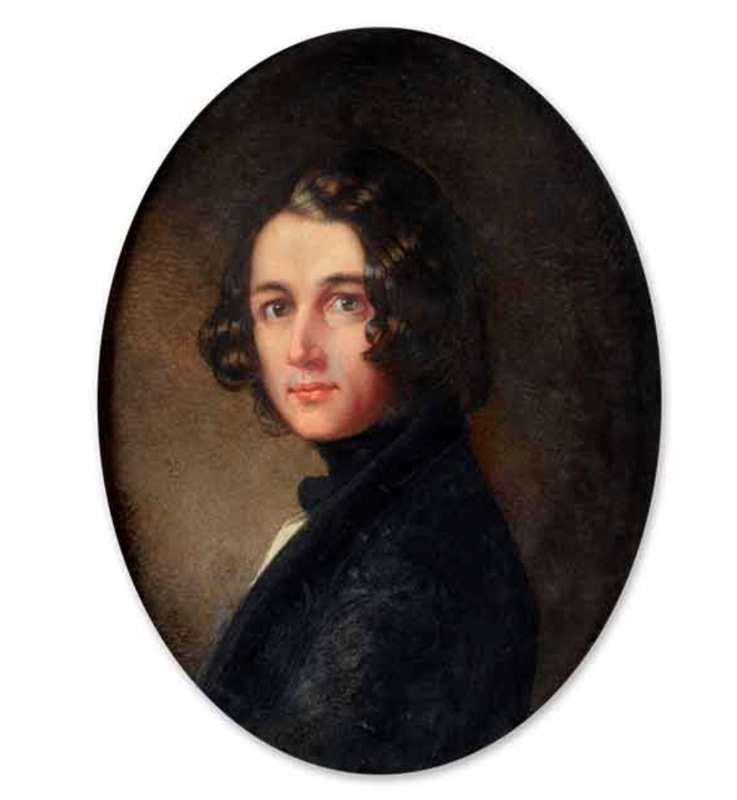|
My dad loved author Charles Dickens' works. He gave a paperback copy of David Copperfield. We watched A Christmas Carol every year. I thought it was sooooo cool that art and writing came together recently! A Lost portrait of Charles Dickens rediscovered in South Africa!!! The portrait was painted about the time Dickens was writing A Christmas Carol. Read on for more info, and, here's the original link: http://artdaily.com/news/109350/Lost-portrait-of-Charles-Dickens-rediscovered-in-South-Africa Smiles, with paint on my hands, Angeline Lost portrait of Charles Dickens rediscovered in South Africa
Margaret Gillies RWS (1803–1887), Portrait of Charles Dickens (1812–1870), courtesy Philip Mould & Company. LONDON.- The lost portrait of Charles Dickens as an emerging literary star at the age of 31, officially lost for 174 years, has miraculously turned up in a box of trinkets in South Africa. Painted in late 1843 by Margaret Gillies (1803–1887) during the same weeks Dickens was writing A Christmas Carol, it was last seen in public in 1844 when exhibited at the Royal Academy of Arts in London. The portrait has now returned to us in time for the 175th anniversary of Dickens’ Christmas masterpiece, first mentioned by the author in a letter dated to a day he was sitting for Gillies. This evening, the art dealers Philip Mould & Company, who formally re-identified the portrait, will unveil it after an interlude of over a century and a half. It will go on display in an exhibition, ‘Charles Dickens: The Lost Portrait’, opening tomorrow and running until 25th January 2019. Until now the portrait has been known only by a simplified black-and-white print, which has none of the brilliance of the original and was the frontispiece of a book entitled A New Spirit of the Age (1844). Edited by Richard Henry Horne, this collection of essays highlighted the great figures of the early Victorian period, from Alfred Tennyson and Robert Browning to Romantic stalwarts such as William Wordsworth and Mary Shelley. Dickens was the first entry. Despite attempts to locate the portrait during her lifetime, even Gillies herself was at a loss to know what had happened to it, reporting it unaccounted for in 1886. Dickens’ contemporary, the poet Elizabeth Barrett Browning, had seen the original and remarked that it showed him as having ‘the dust and mud of humanity about him, notwithstanding those eagle eyes.’ When it was rediscovered a layer of mould was obscuring part of Dickens’ body. It has now undergone conservation work which reveals the stunning detail beneath. Philip Mould has said: ‘This portrait adds greatly to our perception of the charismatic young blade that Dickens was at the time and is so different to the avuncular, bearded man we know from photographs. Unlike other literary portraits of the period, that can be formulaic, the subject fixes you with an arresting gaze, boring into you with the same eyes that recorded a wealth of material about his life and times.’ Dr Cindy Sughrue, Director of the Charles Dickens Museum has commented: ‘This discovery would have been remarkable in any event, but it is even more so because the portrait itself is exquisite. The skill of the artist is evident in the fineness of every brushstroke, in each strand of hair and the sparkling eyes that look right into yours.’ The lost portrait is also remarkable for being made by a professional woman, herself an important and overlooked artist and social campaigner. Well known as a miniaturist, Margaret Gillies painted a portrait of the poet William Wordsworth amongst others. An early supporter of women’s suffrage, she never married but co-habited with her partner, the pioneering sanitary reformer and physician Dr Thomas Southwood Smith (1788–1861). She provided the illustrations for a report by Southwood Smith for the Royal Commission of Inquiry into Children’s Employment in Mines and Manufactories (1842). These images provided a graphic and disturbing account of the exploitation of poor children in Victorian society; a radical subject for a woman artist to take up and work which Gillies executed anonymously. Gillies shared with Dickens a passion for social reform and a deeply felt concern for those living in poverty. The sittings for the lost portrait, which started in late 1843, coincided with one of Dickens’ most intense and ground-breaking periods of social campaigning – the six weeks in which he wrote A Christmas Carol. Dickens first mentions the book in a letter dated the same day as one of his sittings. Initially intending to write a pamphlet about child poverty, he diverted to writing a short ghost story with a clear political agenda. A Christmas Carol catapulted Dickens to even greater fame and can be said to have saved his reputation, which was suffering from the poor reception of his most recent novel, Martin Chuzzlewit (1842–1844). Emma Rutherford, portrait miniature specialist and consultant for Philip Mould & Company, remarked: ‘To have a portrait of Dickens at this specific time – when his career was on a knife-edge – makes it all the more compelling. His future was uncertain – he was overdrawn, with a growing family and living beyond his means. Gillies seems to capture both vulnerability and confidence.’ It is unknown how the portrait came to be in South Africa, but research undertaken by Philip Mould & Company strongly suggests that it arrived via one of two sons of George Henry Lewes (partner to George Eliot), both of whom emigrated to South Africa in the 1860s. Both Gillies and Dickens were close to the Lewes family and Gillies’ adopted daughter was married to another of Lewes’ sons. The portrait was found at a general sale in a tray containing a number of antiques and everyday objects, including an old recorder, a brass dish and a metal lobster. Suspecting the portrait might be of note, its purchaser contacted Philip Mould & Company. The miniature will be on view to the public for the duration of the exhibition, which will also include a number of important loans from the Charles Dickens Museum pertaining to Dickens’ early career, his commitment to self-promotion and his fascination with celebrity and selfhood. His mirror and hairbrush will appear alongside his travelling writing box, one of his quills, a portrait bust from 1842 and a small portrait of his children, as well as a first edition copy of A Christmas Carol. The intention is that the portrait becomes part of the permanent collection of the Charles Dickens Museum at 48 Doughty Street, the only house in which Dickens lived in London that survives. As the portrait goes on display, the Museum, which holds the world's most comprehensive collection of material relating to the life and work of Dickens, is beginning a campaign to raise the necessary funds to secure the future of the painting. ‘The discovery of this long-lost portrait of Charles Dickens by Margaret Gillies is truly thrilling,’ said Cindy Sughrue. ‘The Chares Dickens Museum is the perfect place to provide it with a permanent home, and today we are launching an appeal for contributions towards the cost of acquiring the portrait for our permanent collection.’ Comments are closed.
|
CategoriesAll Art In The News Art Studio Cats Classes Costa Rica Painting Painting Studio Pets Sketching Drawing, painting both analog and digital, and other artsy things while living in Costa Rica.
You can follow my blog the easiest by adding your email to my list by going here. I keep that list secret because I don’t like spammers, too. You’ll even get things that I don’t share in my blogs! |


 RSS Feed
RSS Feed
